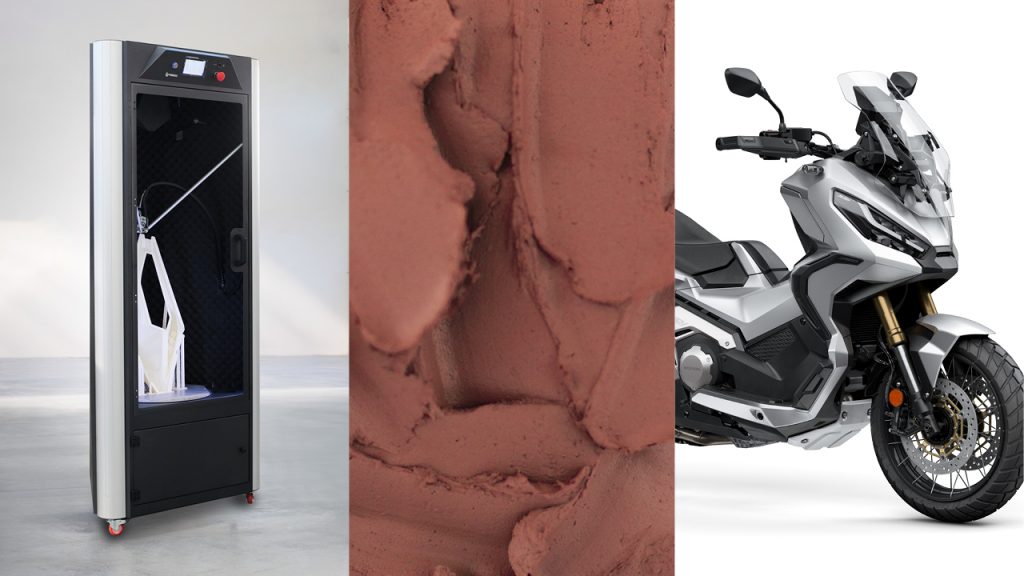Japanese automotive manufacturer Honda has incorporated Italian 3D printer OEM WASP’s technology into the R&D of its motorbikes to develop a unique hybrid prototyping approach.
As opposed to the rest of the two-wheeler industry, where manual clay modelling remains the norm, Honda has combined 3D printing with hand-finishing to shorten its vehicles’ time to market. By mixing both disruptive and traditional techniques, the company has effectively managed to modernize its production workflow, without losing any of the artistry that makes hand-crafted motorcycles so special.

Honda’s hybrid approach
Currently, it’s common practise within motorbike manufacturing to use industrial clay as a means of prototyping new part designs. While traditional manual modelling does have its upsides, notably allowing the skill of the individual sculptor to shine through, it is by its very nature slower and more methodical than more throughput-oriented techniques.
In an attempt to bring clay modelling and mass-manufacturing together, Honda’s European R&D division has therefore integrated WASP’s 3D printing technology into its creative process. After considerable tweaking and comparing of notes between Honda’s Design Modeling Coordinator Antonio Arcadu, and the Italian firm’s engineers, the design team have managed to create a novel hybrid prototype.
Although neither firm has disclosed the exact nature of the part produced, it’s said to represent a “breakthrough in motorcycle modelling,” that retains elements of the hand-finishing seen in existing clay models. Following their initial success, Honda and WASP intend to continue developing their novel approach, with the aim of showcasing their achievements in the months ahead.

WASP’s clay-printing expertise
Established in 2012, WASP specializes in developing circular production processes, and in particular, systems that are capable of using clay-based feedstock to build sustainable architecture. In 2018, for instance, the company deployed its CRANE WASP 3D printer to fabricate a 9.8 foot tall ‘Gaia’ bio-building out of naturally-sourced raw materials.
Since then, WASP has 3D printed its ‘TECLA’ eco-habitat, an organic proof-of-concept that’s designed to provide a blueprint for a new sustainable housing model. Building on the success of the Gaia, the firm’s latest structure has been printed entirely out of recyclable materials, such as biomatter and local soil.
Aside from WASP’s forays into sustainable construction, its technology has also been deployed within clay-specific applications. Back in October 2019, the company leveraged its DeltaWASP 40100 Clay 3D printer to produce additive manufactured ikebana vases, for the esteemed Italian artist and sculptor Andrea Salvatori.
The system enabled Salvatori to either deposit material directly onto the floor or a removable steel surface, meaning that he didn’t have to wait for the clay to dry, thus aiding his creative process. WASP also claims to have been experimenting with different methods of extruding industrial clay since 2017, and through its partnership with Honda, these efforts now appear to have come to fruition.
Advances in clay 3D printing
As construction 3D printing firms continue to strive for scalability, researchers are also working to support them with new clay-based materials, which are specifically designed to yield durable structures. For example, a team from TU Delft has developed a unique clay cement, with optimized viscosity for large-scale extrusion additive manufacturing.
Elsewhere, a coalition of scientists have used 3D printed clay within medicinal applications, to create novel 3D bioprinted scaffolds. By combining a nanoclay suspension called Laponite with bone marrow cells, the researchers were able to produce tissue-like structures, which could aid skeletal regeneration.
Likewise, Chinese scientists have formulated a 3D printable polymer/clay nanocomposite, that’s specifically designed to support bone cell growth. The team’s cellular scaffolds, which have been tested in-vivo, could prove capable of treating bone defects such as those caused by trauma, deformities, or tumor removal.
To stay up to date with the latest 3D printing news, don’t forget to subscribe to the 3D Printing Industry newsletter or follow us on Twitter or liking our page on Facebook.
Are you looking for a job in the additive manufacturing industry? Visit 3D Printing Jobs for a selection of roles in the industry.
Featured image shows Honda’s city adventure concept. Image via Honda.



